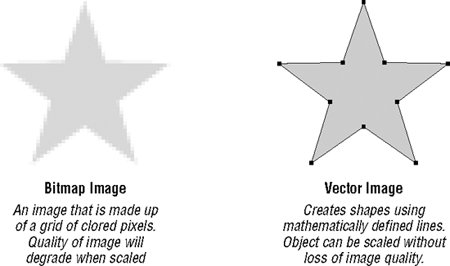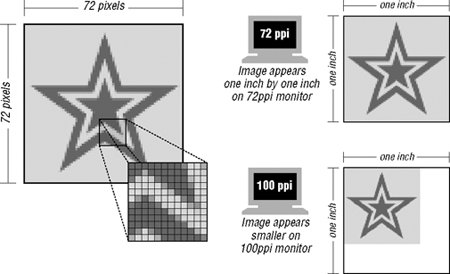Section 28.2. Image Resolution
28.2. Image ResolutionGIFs, JPEGs, and PNGs are pixel-based, or bitmapped (also called raster ), images. When you zoom in, you can see the image is like a mosaic made up of many pixels (tiny, single-colored squares). These are different from vector graphics that are made up of smooth lines and filled areas, all based on mathematical formulas (Figure 28-1). Figure 28-1. Bitmapped versus vector graphics When dealing with bitmapped images , you must be aware of the resolution, usually measured in the number of pixels per inch (ppi) of the image. On the Web, graphics are always displayed on low-resolution monitors, so high resolutions typical of print are unnecessary. Web designers typically create graphics at a resolution of 72 ppi as compared to 266 ppi, 600 ppi, or even higher resolutions common to print design. Working at a low resolution may be an adjustment for a designer accustomed to handling the hi-res images appropriate for print. Most notably, the image quality is lower because there is not as much image information in a given space. This tends to make the image look more grainy or pixelated, and unfortunately, that's just the nature of images on the Web. 28.2.1. Image SizeWhen a graphic is displayed on a web page, the pixels in the image map one to one with the display resolution of the monitor. Monitors with a higher display resolution use smaller pixels. Therefore, a graphic that appears to be about one inch square on your 72 ppi monitor may actually appear to be quite a bit smaller on a monitor with a resolution closer to 100. See Figure 28-2. Figure 28-2. The size of an image is dependent on monitor resolution 28.2.2. Good Bye Inches, Hello PixelsBecause the final dimensions of a graphic are dependent on the resolution of the monitor, the whole notion of "inches" and even "pixels per inch" becomes irrelevant in the web environment. So while 72 ppi has become the de facto standard, in the end, the only meaningful measurement of a web graphic is its actual number of pixels. After a while, thinking in pixels comes quite naturally. What's important is the size of the graphic relative to other graphics on that page and to the overall size of the browser window. For instance, if I want a header graphic to fit in an 800 x 600 monitor, I would make sure that it measures 760 pixels wide or less (to allow for the margins and scrollbar). Other graphics on the page will be measured in pixels relative to that image. After this example, it should be fairly clear why graphics scanned in or shot on a digital camera at high resolutions (such as 300 dpi) are inappropriate for the Web. At higher resolutions, it's typical for images to be several thousand pixels across. With browser windows as small as 750 pixels wide, all those pixels are unnecessary and result in graphics that extend well beyond the browser window. |
EAN: 2147483647
Pages: 325